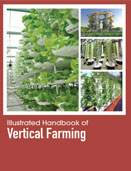Handbooks

Vertical farming is the practice of producing food in vertically stacked layers, such as in a skyscraper, used warehouse, or shipping container. The modern ideas of vertical farming use indoor farming techniques and controlled-environment agriculture (CEA) technology, where all environmental factors can be controlled. This handbook introduces commercial-scale vertical farming and discusses the recent growth of vertical farms in urban areas. It describes the major types of vertical farms and discusses environmental issues with vertical farms.
Vertical farming is the practice of producing food in vertically stacked layers, such as in a skyscraper, used warehouse, or shipping container. The modern ideas of vertical farming use indoor farming techniques and controlled-environment agriculture technology, where all environmental factors can be controlled. These facilities utilize artificial control of light, environmental control and fertigation. In a well-managed Vertical Farm System there are no such thing as ?seasonal crops? and there are no crop losses. Vertical Farm Systems are fully enclosed and climate controlled, completely removing external environment factors such as disease, pest or predator attacks.
Illustrated Handbook of Vertical Farming presents the tactics needed to ensure adequate and efficient production of food, to take a practical approach to the planning, design, and implementation of vertical farming practices. The advent of agriculture has ushered in an unprecedented increase in the human population and their domesticated animals. Farming catalyzed our transformation from primitive hunter-gatherers to sophisticated urban dwellers in just 10,000 years. Today, over 800 million hectares is committed to soil-based agriculture, or about 38% of the total landmass of the earth. This singular invention has facilitated our growth as a species to the point now of world domination over the natural world from which we evolved. Modern agriculture employs a multitude of chemical products, and exposure to toxic levels of some classes of agrochemicals have created other significant health risks that are only now being sorted out by epidemiologists and toxicologists. As if that were no enough to be concerned about, it is predicted that over the next 50 years, the human population is expected to rise to at least 8.6 billion, requiring an additional 109 hectares to feed them using current technologies, or roughly the size of Brazil. That quantity of additional arable land is simply not available. Without an alternative strategy for dealing with just this one problem, social chaos will surely replace orderly behavior in most over-crowded countries. Novel ways for obtaining an abundant and varied food supply without encroachment into the few remaining functional ecosystems must be seriously entertained. If vertical farming in urban centers becomes the norm, then one anticipated long-term benefit would be the gradual repair of many of the world?s damaged ecosystems through the systematic abandonment of farmland. In temperate and tropical zones, the re-growth of hardwood forests could play a significant role in carbon sequestration and may help reverse current trends in global climate change. Other benefits of vertical farming include the creation of a sustainable urban environment that encourages good health for all who choose to live there; new employment opportunities, fewer abandoned lots and buildings, cleaner air, safe use of municipal liquid waste, and an abundant supply of safe drinking water. Illustrated Handbook of Vertical Farming explores everything the home gardener needs to know to start using hydroponics: how plants grow; buying or building systems; pH levels; seeds, etc. This Handbook is intended to students and researchers involved in the field of indoor, intensive, high-tech urban farming.